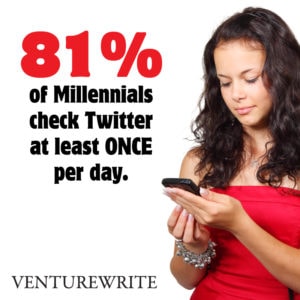There is a mystery behind the hashtag. Twitter decided to use the # symbol to find a way to organize different ideas, to allow them to become searchable and it has now turned into something else entirely. My guess is that my son will never actually know the words “pound symbol” and what they refer to.
 What is a Hashtag?
What is a Hashtag?
In it’s simplest terms, a hashtag is a searchable phrase or word. In most, if not all platforms at this point, it is also a link to bring up all of the posts associated with that exact hashtag or something similar. If you have never clicked on one then I suggest you do it. Depending on the hashtag you can get quite a bit of information from one small click.
When and how to use hashtags effectively are the big challenge here. Some people LOVE their hashtags – and I mean to an extreme. You do not and I repeat, do not have to use 30 hashtags in one post. You can, but similar to finding the right target market with a Facebook ad, it isn’t always the best use of your time and energy.
So how many do you use?
Depending on the platform – one to three. On Facebook less is more. I try to max out at two hashtags per post on Facebook. On Twitter I will use three but work to weave it into my message.
That is one big difference from Twitter and every other platform. You can type or speak in hashtags on Twitter. Every other platform it’s better to keep them at the end of your comments or post.
Instagram is the big one where everyone will go hashtag crazy. The problem is, that that is similar to the spaghetti theory (throw it out there and see what sticks) – if I put enough hashtags on there then enough people will see it. True – but will the RIGHT people see it? That is the challenge with hashtags. Now – to get back to Instagram quickly – follow the same rule, one to three highly targeted hashtags. If you absolutely need to put more in – then use your first comment of the post to do it.
How do I know which ones?
This goes back to your niche market. Do you know exactly who your target market is? If you have determined your exact demographic then seek them out on the platform you are working to attract them on. Look at the hashtags they are using themselves and see if it would be relevant for your brand. Also look at the influencers in your market – what hashtags are they using? What type of results are they getting?
The more specific you are, the higher the chances are that you are reaching the exact market you are searching for. Once you determine two to three solid hashtags then you can begin to expand and look for other angels but the key to determining the hashtags that work? You need to track it.
How you track it doesn’t really matter, meaning use a spreadsheet on your phone, app, etc – just the act of tracking it is what is important. Tracking allows you to determine what works the best. Which individual hashtag has gotten the most engagements and what combination of hashtags has delivered the best results should be the two main focuses of your tracking.
Other hashtags that are important are those that will start a conversation and engage your followers. Seeking out a trending hashtag is important to stay on top of the days events and stay relevant to your audience. Chocolate Chip Cookie Day? Yes, it has a hashtag. So do current events, holidays and just trending topics. The fastest way to find out a trending topic for me is to check out Twitter. But you can also google trending hashtags or go to hashtag.org and see what they have as a popular hashtag as well.
The art of a branded hashtag
There are a few ways to go with hashtags. As described above, you find the hashtags your target demographic is using and then use those same ones. You can create a hashtag especially for your brand and encourage your audience to use it to increase engagement and hope it goes viral. The third option that I don’t recommend most brands use – is the made up hashtag. While it is ideal for comedians and some personal brands who want to express their personality, it is not ideal for most businesses. You know the ones I’m talking about – #ijustwanttomakeupahashtag, #thursdaycomputerproblems or #isitfridayyet. They all seem innocent enough – but the purpose of a hashtag is so that someone can find your brand and relate. If you are going to focus on one to three of them – don’t waste your effort on a made up one unless you are trying to use it as a brand hashtag.
it is ideal for comedians and some personal brands who want to express their personality, it is not ideal for most businesses. You know the ones I’m talking about – #ijustwanttomakeupahashtag, #thursdaycomputerproblems or #isitfridayyet. They all seem innocent enough – but the purpose of a hashtag is so that someone can find your brand and relate. If you are going to focus on one to three of them – don’t waste your effort on a made up one unless you are trying to use it as a brand hashtag.
What have you found works for your business with hashtags? I would love to hear your point of view!



I appreciate, cause I found just what I was looking for. You’ve ended my 4 day long hunt! God Bless you man. Have a nice day. Bye
So glad I could help!